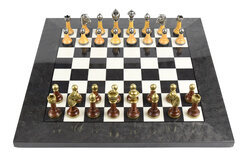The Rules of Shogi or Japanese Chess
Shogi is the Japanese version of Chess and some believe the most complex of all traditional Chess variants. The fundamental difference is that when pieces are captured they can be re-entered onto the board playing for the opposing side. This brings Japanese Chess a great advantage over other forms of chess in that draws are a mercifully rare event.
See also: Shogi - Japanese Chess.
Equipment
The game of Japanese Chess or Shogi is played on a board of 81 squares - 9 x 9. The pieces for each player consist of
- 9 Footsoldiers (here called Pawns)
- 2 Lances
- 2 Honorable Horses (here called Knights)
- 2 Silver Generals
- 2 Gold Generals
- 1 Bishop
- 1 Flying Chariot (here called a Rook)
- 1 Jewelled General (here called the King).
Preparation and Objective
Each player's nine Pawns are placed on the third nearest row to the player. The Rook and the Bishop are placed on the second row one space in from the edge, the Rook on the right, the Bishop on the left. The remaining pieces are placed on the row nearest to the player in the following way: the Lances in each corner, the Knights on the next square in from the corner, the Silver Generals next to the Knights. The middle square on the nearest row holds the King with the Gold Generals either side of him. The objective of Japanese Chess is to capture the opposing player's King. The King is never actually taken; instead the aim is put the opponent's King into a position such that the opposing player can do nothing to avoid the King being taken next turn. As soon as this happens, the victorious player who has just moved says "checkmate" and the game is over.
Basic Play for Shogi
Players take turns to move a piece that belongs to them. Each piece is moved according to different rules but no two pieces can occupy the same square. If a piece moves so that its final position is a square occupied by an opposing piece, the opposing piece is "captured" or "taken" and is removed from the board. Captured pieces should be placed face up within easy view of both players. It is not compulsory to capture.
- King - moves one space in any direction diagonally or orthogonally EXCEPT that the King cannot move onto a square that is attacked by an opposing piece.
- Gold General - moves one space in one of 6 directions - forwards, diagonally forwards, sideways or backwards.
- Silver General - moves one space in one of 5 directions - forwards, diagonally forwards or diagonally backwards.
- Knight - moves two squares forwards and then one square sideways. Only two squares are available to the Knight but, in compensation, it is the only piece that can jump over other pieces.
- Lance - moves any number of spaces forwards.
- Rook - moves any number of spaces orthogonally but cannot jump over another piece.
- Bishop - moves any number of spaces diagonally but cannot jump over another piece.
- Pawn - moves one square forwards only.
Promotion
If a piece other than the Gold General or King makes a move that ends within the promotion zone (the last three rows), then the player can choose to promote that piece. The piece is turned over to reveal the symbol of the promoted piece. If a Pawn or Lance reaches the final row or the Knight reaches the penultimate row, then that piece MUST be promoted. A promoted piece moves as follows:
- Pawn, Lance, Knight & Silver General - when promoted move exactly like a Gold General.
- Promoted Rook (called a Dragon King) - moves like a Rook but acquires the power to move a single square diagonally.
- Promoted Bishop (called a Dragon Horse) - move like a Bishop but acquires the power to move a single square orthogonally.
Drops
The fascinating facet of the game that makes Shogi a superior Chess variety in many people's minds, is the fact that captured pieces are allowed to re-enter the game. Aside from maintaining the complexity of the game, it also means that there is no concept of Stalemate or agreed draws in Shogi. A player with one or more captured pieces can opt to drop a captured piece onto the board instead of moving at any point in the game. The dropped piece can be re-entered onto any vacant square with the following restrictions:
- Pieces drop in the un-promoted state although they can be promoted in subsequent moves according to the usual rules.
- A piece cannot be dropped on a square from which it would never have a legal move (i.e. a Pawn on the last row or a Knight on either of the last two rows).
- Knight on either of the last two rows).
- A player cannot drop a Pawn onto a file (column) where there is already an un-promoted Pawn that belongs to the same player.
- A Pawn cannot be dropped in front of a King in such a way that it would cause the King to become checkmated.
Finishing
Checkmate
When a piece is moved such that a player's King cannot avoid being captured upon the next turn, that player's King is said to be checkmated and the game is over.
Resignation
Once it is believed that the opposing player will inevitably win, a player will normally resign to save time.
These rules are provided by Masters Traditional Games, an Internet shop selling quality traditional games, pub games and unusual games. For general information or for copying and copyright, see our Rules Information page.
Our rules are comprehensive instructions for friendly play. If in doubt, always abide by locally-played or house rules.
Copyright James Masters, 2025. All rights reserved.



























